You might best remember it as a dusty bottle in your parent’s drinks cabinet, or the bottle you crack open when your mother-in-law comes to visit, but it’s time to show some love for vermouth, which is easy to make and even more delightful to quaff.
What is Vermouth?
More commonly known by the brand ‘Martini’, vermouth is simply fortified wine flavoured with botanicals, such as roots and bark, herbs and flowers.
As we’ve mentioned, botanical infusions are one of the big trends of the year, making it the perfect time to revisit this classic drink.
There are two versions of vermouth; the first is the traditional drink created by the Italians, also known as ‘sweet’ or ‘rosso’, which tends to be dark red in colour. This is used in popular cocktails such as Negronis and Manhattans.
The other is dry vermouth, also known as ‘bianco’, which was created in France, and forms a clear liquid with a dry taste - most commonly used in Martinis.
Let’s Go Back
Hailing from Italy, vermouth was initially created sometime in the 18th century, used for medicinal purposes. It grew in popularity until bartenders started to use it frequently in the 19th century, along with the French discovery of dry vermouth.
It’s a key ingredient to many cocktails that we have come to know and love – from Martinis to Manhattans. The first commercial drink ‘Carpano’ dates back to 1786 and is still in production today.
Homemade Versus Shop Bought
The drink is widely available and affordable too. From Noilly Prat’s dry vermouth to Bacardi’s Martini extra dry, and Otto’s Athens vermouth to Tesco’s own version. But where’s the fun in buying it, when you can make it yourself?!
One of the great joys of this drink is that it can be home brewed to capture your favourite flavours and ingredients, and also makes a thoughtful gift for friends and for bringing to parties.
Get Crafty!
Why not join the craft revolution and make your very own brew? It’s simple, to rustle up and can be enjoyed on its own, or as a mixer.
This four-stage process starts with some basic ingredients:
- Fortified wine (like a dry Reisling) 1 liter.
- Sugar, 50-100 grams
- Vodka, 250ml (any you like, but the stronger the better!)
- Herbs of your choice (about 20 grams from a variety of 10-20), here’s a few for consideration
| Citrus: | lemongrass, grapefruit peel, orange or lemon zest |
| Aniseed tones: | angelica, liquorice bark, star anise |
| Floral flavours: | rose petals, lavender |
| Bitterness: | wormwood, rhubarb (dilute with hot water) |
| Herbal: | rosemary, dried chamomile, cardamom pods, sage |
| Sweet: | cinnamon stick, vanilla pods |
| Sharpness: | juniper berries |
Method
- Collect your herbs, if some of these need crushing to release the flavours (such as cardamom), use a rolling pin. Once ready, encase them in a container or large jar, fill with vodka and stir. Seal the container and leave for two weeks in a dark place at room temperature, shaking daily to keep the flavours moving.
- When ready, strain your herbal infusion through a few layers of cloth giving them a good squeeze to extract all the goodness. Replace the lid on the container of liquid and leave for a further 3 hours to settle. Note: the large amount of liquid is not required for the rest of this recipe, it was just required for fermentation, which is harder to achieve with smaller volumes. Therefore, use only half the remaining liquid from here on out.
- Pour your wine into a cooking pot and add the sugar along with your (half measure) of herbal infusion, stirring as you go along. Give it a try, adding more alcohol or sugar to sweeten as preferred. Heat to 60-70°C, then take off the heat and allow it to cool down. Once the sediment has settled, it’s time to strain the liquid.
- Your vermouth is now ready to be bottled, sealing it securely with a cork. Age it in a cellar or fridge to allow all the great flavours to come out. If you can, two to three months is the optimum time, but even 2-3 weeks will suffice. As a general rule – the longer it’s left, the better the taste!
Once opened, your vermouth should be refrigerated with a shelf life of four years.
If you liked this article then why not check out our article How to Make Mead or Homemade Alcohol & Syrups.
If you want to learn more about creating and mixing amazing cocktails to help fund your studies or travels, or you simply want to improve your knowledge and techniques, check out our bartending school.

